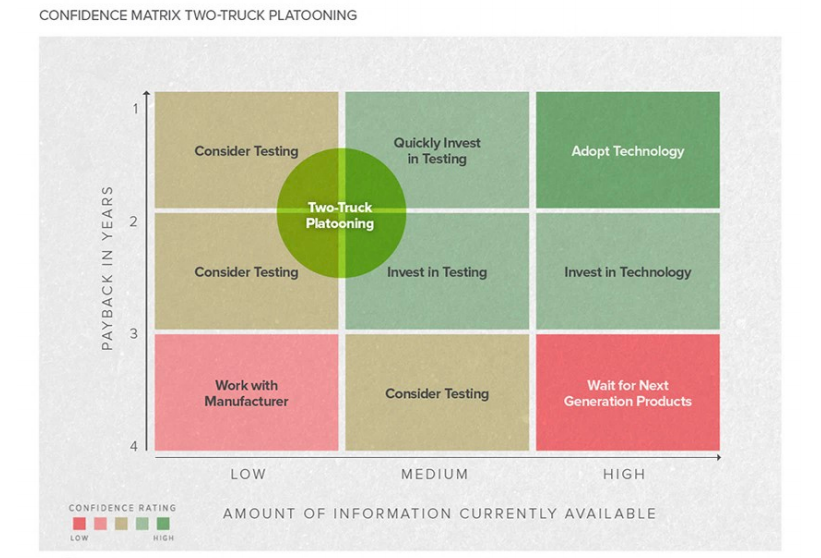Two-Truck Platooning
Two-truck platooning is an emerging technology designed to boost fuel economy performance for tractor-trailers engaged in long- and regional-haul highway applications.

Platooning combines existing commercial vehicle safety technology with emerging vehicle-to-vehicle communications and autonomous vehicle control technology to electronically “tether” tractor-trailers together in a convoy formation at highway speeds.
Once a platoon of trucks is established, the vehicles, safety systems work in unison to draw the trucks together at significantly reduced following distances to overcome each vehicle’s inherent aerodynamic drag.
I’m hearing 3 to 5% fuel economy boost from platooning. The fuel economy benefits are pretty strong. That’s a lot at any fuel price per gallon.
– A Mid-Sized Fleet
Benefits
Fuel Savings Fuel savings depend on many factors. At a 40 – 50 ft. following distance directionally, the front truck can save 4% on fuel and the following truck can save 10%, giving an average of 7% (versus the two trucks not platooning).
The fuel savings of two-truck platooning is likely a 4% average savings over the two trucks in real-world operating conditions after accounting for traffic, terrain and time when equipped trucks will not be operating in a platoon.
Accelerates Adoption of Safety Equipment
Challenges
Payback
The payback for platooning is driven by many factors, including the upfront cost for the equipment, any subscription costs for platooning, the savings in fuel, the costs to mitigate any of the challenges, and the level to which the fleet is already investing in safety technologies.
Driver Acceptance
Drivers must learn, and become comfortable with, an entirely new operational dynamic behind the steering wheel.
Platoon Integrity
There is concern about how drivers will react if a passenger car moves into the gap between the platooning trucks.
System Security
There is concern about hacking of the communication system of the platooning trucks.
Amount of Viable Platooning Time
It is an open question whether platooning might be a viable option only a small percentage of the time and whether any fuel savings would justify the outlay in acquisition and operational costs.
Legislative Efforts & Public Awareness
Changes to traffic laws that reflect the impact this new technology will have on highway transportation need to be considered on both the state and federal levels.
Shared Fuel Savings
Reliability
Reliability of platooning technology systems remains unknown, as there is little field history on these systems.
Litigation
Imbedded in operating costs is a need to address the potential impact of litigation.
What People Are Saying
Comments about platooning center on things like the timeline for its implementation, fuel savings, following distances, driver acceptance, driver pay, cost, and platooning with other fleets.
I’m thinking 2018 to 2030 before we see platooning operations on the road. There are still way too many studies that have to be done on this subject.
— A Major Truckload Fleet Manager
It’s about finding the sweet spot with aerodynamic benefits for both the front and rear vehicles, but also spreading the gap somewhat gives the second driver more to look at and is less fatiguing.
— A Private Fleet Manager
We don’t think the cost will be as high as some groups are forecasting.
— A Technology Developer
The driving experience with platooning has been very similar to normal truck driving today.
— A Test Truck Driver
We’re not sure [about platooning with other fleets]. It will be our position initially that we will not platoon with anyone else.
— A Fleet Manager
While technology may support platooning quite well…I don’t see fleets willing to take the risk in our current environment with litigation.
— A Fleet Manager
Decision-Making Tools
The study team developed a tool to help fleets in making their decision about two-truck platooning. The Confidence Matrix plots where the two-truck platooning choice falls in terms of available data on the technology and how quickly fleets should realize payback.
Conclusions
- The fuel savings of two-truck platooning is likely a 4% average savings over the two trucks in real-world operating conditions after accounting for traffic, terrain and time when equipped trucks will not be operating in a platoon.
- The bulk of the required technology is currently available and being purchased by many fleets.
- Intervals of 40 to 50 ft. will likely have sufficient payback for early adopting fleets and then shorter distances, with their higher fuel savings, can be implemented with product improvements.
- Two-truck platooning is not fully autonomous/driverless trucking and it is actually being improperly grouped with that concept.
- Driver stress will likely be less than perceived to date.
- Platooning will accelerate the adoption of other technologies such as collision avoidance and adaptive cruise control.
